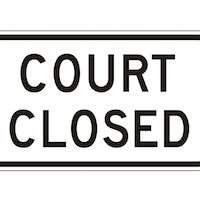Marin Is Only County Court System Not Projecting Double-Digit Funding Shortfall

California court budgets were slashed around $1.1 billion during the economic downturn, forcing courthouses to close, fees to rise and services to be slashed. And the numbers indicate that people with fewer resources have been hit the hardest.
Although Supreme Court Chief Justice Tani G. Cantil-Sakauye expressed satisfaction with this year’s proposed 2015-16 budget, she said last year that it would take $266 million for the judiciary to “tread water.” Governor Jerry Brown threw an extra $180 million at them.
The chief justice has said it would take a $1.1-billion in additional funding over three years to undue the hardship suffered by the court system. They are not going to get that. So, the Judicial Council of California put together budget snapshots of the state’s individual 58 county Superior Courts to illustrate what that means. All of the counties project a shortfall and only one county—wealthy Marin—misses the mark by less than double digits.
Kern County is the worst. The council calculates that the Central Valley county will receive enough funding to meet just 52% of its needs. The $32.9-million shortfall will impact 10 facilities serving 873,092 people. The county is due a 5% increase in the budget, which will just cover its increased operating costs. One courthouse will remain closed indefinitely and another will stay open just one day a week. Court vacancies are running at 12% and 40 deleted court employees are not coming back.
Bankrupt San Bernardino County isn’t much better off. It has a projected 46% budget shortfall. Its 14 facilities serve 2.1 million people, badly. The report describes the Superior Court as “severely undersourced and underfunded.” Only 60% of the 143 judicial positions the court needs are funded. Its judges have caseloads 30% larger than the statewide average.
Six courthouses have closed since fiscal year 2006-07 and night court was eliminated countywide in March 2013. “Court no longer provides forms” for self-help, mediation and facilitator services” Litigants without technology in poorest areas spend extra hours in line waiting to purchase them.”
Stanislaus County (pop: 1.6 million) checks in at the #3 position, with a 44% shortfall. The average wait time for self-help, mediation and facilitator services doubled when the staff was cut from seven to four. They have been down three court reporters since 2011-12 and “staffing shortages do not allow processing of daily workload.” The county has seven facilities; two others are closed.
Los Angeles County is near the frontrunners, with a 39% shortfall, but its enormous population means more people are screwed there than in any other county. Budgeted staff positions have declined 25%. Fifty-six courtrooms were eliminated in 2012 and the next year, eight courthouses and 23 courtrooms were whacked. Since then, wait times at the Stanley Mosk Courthouse have increased 50%, or 40 days.
Even the best of the bunch, Marin County, is suffering from an 8% shortfall. But when you have money, some hardships can be mitigated. Staff court reporters have declined from 14 to eight, so “parties are advised to bring their own court reporters to civil and family evidentiary hearings.” Which is not to say Marin has not suffered. The court has lost 37% of its workforce since 2008.
The story is similar throughout the state, where 52 courthouses and 202 courtrooms have closed since 2008. The “closures have deprived more than 2 million Californians of access to justice,” according the council. More than 4,000 court staffers have lost their jobs and some courts continue to furlough workers periodically.
Part of the judiciary’s problem is of its own making. The system has been wracked for years by an internal struggle between trial court judges and the centralized judicial bureaucracy, as well as between the individual courts, over policy, governance and distribution of funds. All of this was exacerbated by the collapse of a $1 billion computer project in 2012 that was meant to unify the myriad judicial case management systems across the state, but did not.
–Ken Broder
To Learn More:
Report Outlines Dire Need in Courts (by Shea Johnson, Victorville Daily Press)
Downsized Court System Doesn’t Sweat the Small Stuff like It Used To (by Ken Broder, AllGov California)
In Focus: Judicial Branch Budget Crisis (Judicial Council of California)
San Bernardino County Superior Court Budget Snapshot (pdf)
Budget Snapshots (Judicial Council of California) (pdf)
- Top Stories
- Controversies
- Where is the Money Going?
- California and the Nation
- Appointments and Resignations
- Unusual News
- Latest News
- California Forbids U.S. Immigration Agents from Pretending to be Police
- California Lawmakers Urged to Strip “Self-Dealing” Tax Board of Its Duties
- Big Oil’s Grip on California
- Santa Cruz Police See Homeland Security Betrayal in Use of Gang Roundup as Cover for Immigration Raid
- Oil Companies Face Deadline to Stop Polluting California Groundwater





